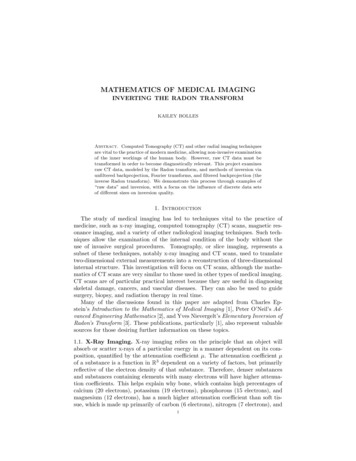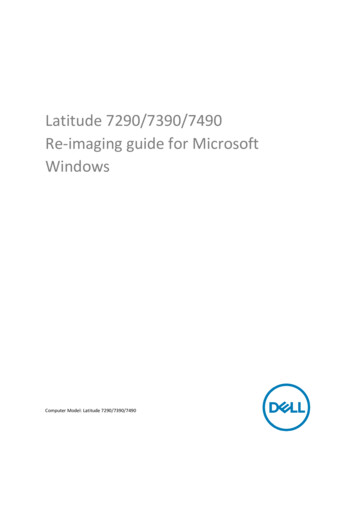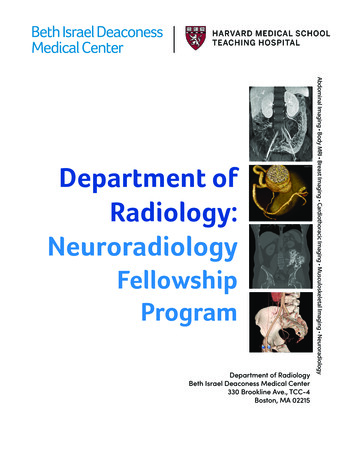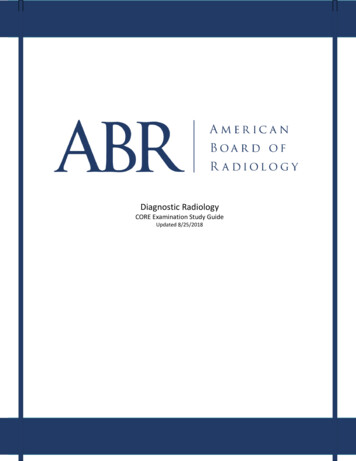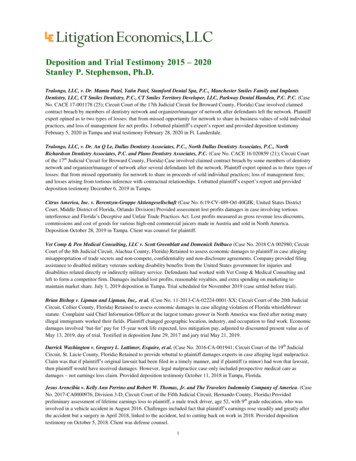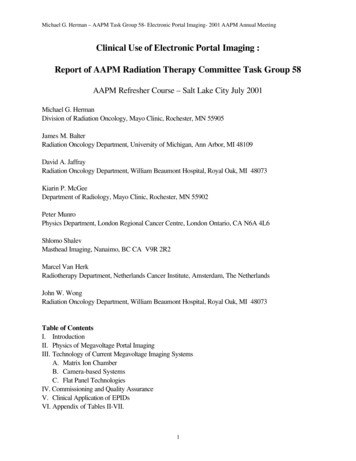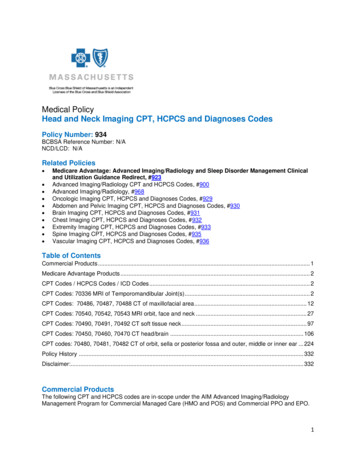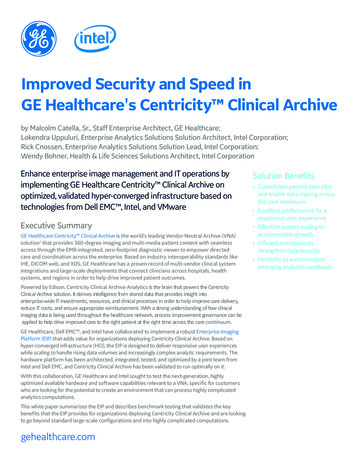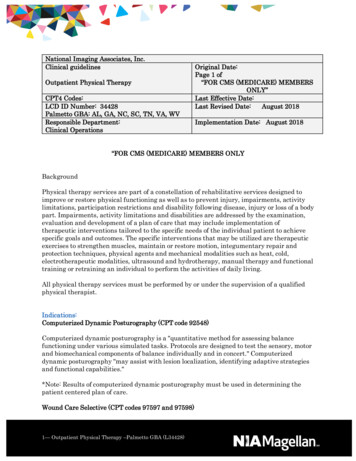
Transcription
National Imaging Associates, Inc.Clinical guidelinesOutpatient Physical TherapyCPT4 Codes:LCD ID Number: 34428Palmetto GBA: AL, GA, NC, SC, TN, VA, WVResponsible Department:Clinical OperationsOriginal Date:Page 1 of“FOR CMS (MEDICARE) MEMBERSONLY”Last Effective Date:Last Revised Date:August 2018Implementation Date: August 2018“FOR CMS (MEDICARE) MEMBERS ONLYBackgroundPhysical therapy services are part of a constellation of rehabilitative services designed toimprove or restore physical functioning as well as to prevent injury, impairments, activitylimitations, participation restrictions and disability following disease, injury or loss of a bodypart. Impairments, activity limitations and disabilities are addressed by the examination,evaluation and development of a plan of care that may include implementation oftherapeutic interventions tailored to the specific needs of the individual patient to achievespecific goals and outcomes. The specific interventions that may be utilized are therapeuticexercises to strengthen muscles, maintain or restore motion, integumentary repair andprotection techniques, physical agents and mechanical modalities such as heat, cold,electrotherapeutic modalities, ultrasound and hydrotherapy, manual therapy and functionaltraining or retraining an individual to perform the activities of daily living.All physical therapy services must be performed by or under the supervision of a qualifiedphysical therapist.Indications:Computerized Dynamic Posturography (CPT code 92548)Computerized dynamic posturography is a "quantitative method for assessing balancefunctioning under various simulated tasks. Protocols are designed to test the sensory, motorand biomechanical components of balance individually and in concert." Computerizeddynamic posturography "may assist with lesion localization, identifying adaptive strategiesand functional capabilities."*Note: Results of computerized dynamic posturography must be used in determining thepatient centered plan of care.Wound Care Selective (CPT codes 97597 and 97598)1— Outpatient Physical Therapy –Palmetto GBA (L34428)
Debridement: Debridement is indicated whenever necrotic tissue is present on a documentedopen wound. Debridement may also be indicated in cases of abnormal wound repair.a)Conservative Sharp Debridement:Conservative sharp debridement is a minor procedure that requires no anesthesia and isperformed on an outpatient basis. Scalpel, scissors, and forceps may be used and only clearlyidentified devitalized tissue is removed. Generally, there is no specific bleeding associatedwith this procedure.Wound(s) Care Non-Selective Debridement (CPT code 97602) and Negative Pressure WoundTherapy (CPT codes 97605 and 97606)a)Enzymatic Debridement:Debridement with topical enzymes is used when necrotic substances to be removed from awound are protein, fibrin and collagen. The manufacturer's product insert containsindications, contraindications, precautions, dosage, and administration. It would be theclinician's responsibility to comply with the product insert/guidelines.b)Autolytic Debridement:This type of debridement is indicated where manageable amounts of necrotic tissue arepresent, and there is no infection. Autolytic debridement occurs when the enzymes that arenaturally found in wound fluids are sequestered under synthetic dressings. Autolyticdebridement is contraindicated for wounds that contain infection.c)Mechanical Debridement:Wet-to-moist dressings may be used with wounds that have a high percentage of necrotictissue. Wet-to-moist dressings should be used cautiously as maceration of surroundingtissue may hinder healing.Hydrotherapy and wound irrigation are also forms of mechanical debridement used toremove necrotic tissue. They also should be used cautiously, as maceration of surroundingtissue may hinder healing.d)Negative Pressure Wound Therapy:Negative Pressure Wound Therapy is a non-invasive treatment by which controlled localizednegative pressure is delivered to a wide variety of acute, sub-acute, and chronic wounds.Negative Pressure Wound Therapy should be used cautiously as maceration of surroundingtissue may hinder healing.2—Outpatient Physical Therapy –Palmetto GBA (L34428)
Fabrication/Application of Casts, Splints and Strapping (CPT codes- see below)Fabrication and application of casts, splints, and strapping (e.g., the use of elastic wraps,heavy cloth, adhesive tape) will be considered reasonable and necessary if used to supportweak or ineffective joints/muscles, reduce/correct joint limitations/deformities and/or protectbody parts from injury, thus enhancing the performance of tasks or movements. The casts,splints and strapping are often used in conjunction with therapeutic exercise, functionaltraining, and other interventions and should be selected in the context of patient needs andsocial/culture environments.BODY AND UPPER EXTREMITY CASTSApplication of long arm cast (CPT code 29065)May be indicated for the shoulder and/or elbow in the treatment of fractures, dislocations,sprains/strains, tendonitis, post-op reconstruction, contractures and/or other deformitiesinvolving soft tissue.Application of short arm cast (CPT code 29075)May be indicated for the forearm, wrist and/or hand in the treatment of fractures,dislocations, sprains/strains, tendonitis, post-op reconstruction, contractures or otherdeformities involving soft tissue.Application of hand and lower forearm cast (CPT code 29085)May be indicated for the forearm, wrist and/or hand in the treatment of fractures,dislocations, sprains/strains, tendonitis, post-op reconstruction, contractures or otherdeformities involving soft tissue.Application of long arm splint (CPT code 29105)May be indicated for the shoulder and/or elbow in the treatment of fractures, dislocations,sprains/strains, tendonitis, post-op reconstruction, contractures or other deformitiesinvolving soft tissue.Application of short arm splint (CPT codes 29125 and 29126)May be indicated for the forearm, wrist and/or hand in the treatment of fractures,dislocations, sprains/strains, tendonitis, post-op reconstruction, contractures or otherdeformities involving soft tissue.Application of finger splint (CPT codes 29130 and 29131)May be indicated for the finger in the treatment of fractures, dislocations, sprains/strains,3—Outpatient Physical Therapy –Palmetto GBA (L34428)
tendonitis, post-op reconstruction, contractures or other deformities involving soft tissue.STRAPPING-ANY AGEStrapping of thorax (CPT code 29200)May be indicated for the thoracic spine, lumbar spine, rib cage or abdominal musculature inthe treatment of contusions, dislocations, fractures, sprains/strains, post-op conditions,neuromuscular conditions, contractures or other deformities involving soft tissue.Strapping of low back (CPT code 29799)May be indicated for the lumbar spine, rib cage or abdominal musculature in the treatmentof contusions, dislocations, fractures, sprains/strains, post-op conditions, neuromuscularconditions, contractures or other deformities involving soft tissue.Strapping of shoulder (e.g., Velpeau)(CPT code 29240)May be indicated for any portion of the shoulder girdle complex, or rib cage in the treatmentof contusions, dislocations, fractures, sprains/strains, post-op conditions, neuromuscularconditions, contractures or other deformities involving soft tissue.Strapping of elbow or wrist (CPT code 29260)May be indicated for the elbow or wrist when there is involvement of the humerus, forearm,wrist or hand in the treatment of contusions, dislocations, fractures, sprains/strains, post-opconditions, neuromuscular conditions, edema, scar management, contractures or otherdeformities involving soft tissue.Strapping of hand or finger (CPT code 29280)May be indicated when there is involvement of the hand or finger(s) in the treatment ofcontusions, dislocations, fractures, sprain/strains, post-op conditions, neuromuscularconditions, edema, scar management, contractures or other deformities involving softtissues.LOWER EXTREMITY CASTSApplication of long leg cast (CPT codes 29345 and 29365)May be indicated when there is involvement of the femur, patella, tibia, fibula, ankle or footin the treatment of contusions, dislocations, fractures, sprains/strains, post-op conditions,contractures or other deformities involving soft tissue.4—Outpatient Physical Therapy –Palmetto GBA (L34428)
Application of short leg cast (CPT code 29405)May be indicated when there is involvement of the tibia, fibula, ankle or foot in thetreatment of contusions, dislocations, fractures, sprains/strains, post-op conditions,contractures or other deformities involving soft tissue.Application of rigid leg cast (CPT code 29445)May be indicated for recent amputees or patients with lower extremity ulcers.Application of long leg splint (CPT code 29505)May be indicated when there is involvement of the femur, patella, tibia, fibula, ankle or footin the treatment of contusions, dislocations, fractures, sprains/strains, post-op conditions,contractures or other deformities involving soft tissue.Application of short leg splint (CPT code 29515)May be indicated when there is involvement of the tibia, fibula, ankle or foot in thetreatment of contusions, dislocations, fractures, sprains/strains, post-op conditions,contractures or other deformities involving soft tissue.STRAPPING-ANY AGEStrapping of hip (CPT code 29520)May be indicated when there is involvement of the lower back, abdomen or hip in thetreatment of contusions, dislocations, fractures, sprains/strains, post-op conditions,neuromuscular conditions, contractures or other deformities involving soft tissue.Strapping of knee (CPT code 29530)May be indicated when there is involvement of the thigh, knee, or lower leg in the treatmentof contusions, dislocations, fractures, sprains/strains, post-op conditions, neuromuscularconditions, contractures or other deformities involving soft tissue.Strapping of ankle and/or foot (CPT code 29540)May be indicated when there is involvement of the lower leg, ankle and/or foot in thetreatment of contusions, dislocations, fractures, sprains/strains, post-op conditions,neuromuscular conditions, contractures or other deformities involving soft tissue.Strapping of toes (CPT code 29550)May be indicated when there is involvement of any of the toes in the treatment of5—Outpatient Physical Therapy –Palmetto GBA (L34428)
contusions, dislocations, fractures, sprains/strains, post-op conditions, neuromuscularconditions, contractures or other deformities involving soft tissue.Application of unna boot (CPT code 29580)A dressing for ulcers resulting from venous insufficiency, consisting of a paste made fromgelatin zinc oxide and glycerin, which is applied to the leg, then covered with a spiralbandage, this in turn being given a coat of the paste. The process is repeated untilsatisfactory rigidity is attained.Biofeedback training any method and biofeedback training perineal muscles, anorectal orurethral sphincter including EMG and/or manometry (CPT codes 90901 and 90911)The coverage criteria and definition of biofeedback therapy is found in the CMS InternetOnly Manual, Pub 100- 03, Medicare National Coverage Determinations Manual, Chapter 1,Part 1, §§30.1 and 30.1.1"Biofeedback is a tool utilized by physical therapists to assist with muscle training. Thisincludes facilitation of muscles that are demonstrating suboptimal performance as well asrelaxation of muscles that may be inhibiting coordinated movement. Biofeedback can bevisual or auditory."Muscle testing, manual (CPT Codes 95831-95834)The series of codes 95831-95834 "are intended to report manual test of muscles or musclegroups for strength based on grading scales."Muscle testing, manual (separate procedure) with report; extremity (excluding hand) ortrunk (CPT code 95831)To use this code for extremity manual muscle testing, every muscle of at least one extremitywould need to be tested, with documentation of why such a thorough assessment waswarranted.Muscle testing, manual (separate procedure) with report; hand, with or without comparisonwith normal side (CPT code 95832)Muscle testing, manual (separate procedure) with report; total evaluation of body, excludinghands or including hands (CPT codes 95833 and 95834)The measurement of muscle performance using manual muscle testing only.Range of Motion Measurements (CPT codes 95851 and 95852)Determination of range of motion using a tape measure, flexible ruler, electronic device or6—Outpatient Physical Therapy –Palmetto GBA (L34428)
goniometer.To use CPT code 95851 for extremity range of motion testing, every joint of an extremitywould need to be tested, with documentation of why such a thorough assessment waswarranted.PT Evaluation-CPT codes 97161 (low complexity), 97162 (moderate complexity), and 97163(high complexity) and PT Re-evaluation (CPT code 97164)Evaluation is a comprehensive service that requires professional skills to make clinicaljudgments about conditions for which services are indicated based on objectivemeasurements and subjective evaluations ofpatient performance and functional abilities. Evaluation is warranted e.g., for a newdiagnosis or when a condition is treated in a new setting. These evaluative judgments areessential to development of the plan of care,including goals and the selection of interventions. The time spent in evaluation does notcount as treatment time.1. The initial examination has three components:a. The patient history to include prior level of functionb. Relevant systems reviewsc. Tests and measures Current functional status (abilities and deficits)2. Factors that influence the complexity of the examination and evaluation process includethe clinical findings, extent of loss of function, social considerations, and the patient'soverall physical function and health status. Thus, the evaluation reflects the chronicityor severity of the current problem, the possibility of multi-site or multi-system involvement, the presence of preexisting systemic conditions or diseases, and thestability of the condition. Physical therapists also consider the level of the currentimpairments and the probability of prolonged impairment, functional limitation,disability, the living environment, and the social supports.3. Initial evaluations or reevaluations may be determined reasonable and necessary evenwhen the evaluation determines that skilled rehabilitation is not required if the patient'scondition showed a need for an evaluation, or even if the goals established by the plan oftreatment are not realized.4. Reevaluation is periodically indicated during an episode of care when the professionalassessment indicates a significant improvement or decline in the patient's condition orfunctional status. Some regulations and state practice acts require reevaluation at7—Outpatient Physical Therapy –Palmetto GBA (L34428)
specific intervals. A reevaluation is focused on evaluation of progress toward currentgoals and making a professional judgment about continued care, modifying goals, and/ortreatment or terminating services.5. A reevaluation may be appropriate prior to a planned discharge for the purposes ofdetermining whether goals have been met, or for the use of the physician or thetreatment setting at which treatment will be continued.MAINTENANCE PROGRAMSMAINTENANCE PROGRAM (MP) means a program established by a therapist thatconsists of activities and/or mechanisms that will assist a beneficiary in maximizing ormaintaining the progress he or she has made during therapy or to prevent or slow furtherdeterioration due to a disease or illness.Skilled therapy services that do not meet the criteria for rehabilitative therapy may becovered in certain circumstances as maintenance therapy under a maintenance program.The goals of a maintenance program would be, for example, to maintain functional status orto prevent or slow further deterioration in function.Coverage for skilled therapy services related to a reasonable and necessary maintenanceprogram is available in the following circumstances: Establishment or design of maintenance programs. If the specialized skill, knowledgeand judgment of a qualified therapist are required to establish or design amaintenance program to maintain the patient’s current condition or to prevent or slowfurther deterioration, the establishment or design of a maintenance program by aqualified therapist is covered. If skilled therapy services by a qualified therapist areneeded to instruct the patient or appropriate caregiver regarding the maintenanceprogram, such instruction is covered. If skilled therapy services are needed forperiodic reevaluations or reassessments of the maintenance program, such periodicreevaluations or reassessments are covered. Delivery of maintenance programs. Once a maintenance program is established,coverage of therapy services to carry out a maintenance program turns on thebeneficiary’s need for skilled care. A maintenance program can generally beperformed by the beneficiary alone or with the assistance of a family member,caregiver or unskilled personnel. In such situations, coverage is not provided.However, skilled therapy services are covered when an individualized assessment ofthe patient’s clinical condition demonstrates that the specialized judgment,knowledge, and skills of a qualified therapist are necessary for the performance of safeand effective services in a maintenance program. Such skilled care is necessary for theperformance of a safe and effective maintenance program only when (a) the therapyprocedures required to maintain the patient’s current function or to prevent or slow8—Outpatient Physical Therapy –Palmetto GBA (L34428)
further deterioration are of such complexity and sophistication that the skills of aqualified therapist are required to furnish the therapy procedure or (b) the particularpatient’s special medical complications require the skills of a qualified therapist tofurnish a therapy service required to maintain the patient’s current function or toprevent or slow further deterioration, even if the skills of a therapist are notordinarily needed to perform such therapy procedures. Unlike coverage forrehabilitation therapy, coverage of therapy services to carry out a maintenanceprogram does not depend on the presence or absence of the patient’s potential forimprovement from the therapy.The deciding factors are always whether the services are considered reasonable, effectivetreatments for the patient’s condition and require the skills of a therapist, or whether theycan be safely and effectively carried out by nonskilled personnel or caregivers.Hot or Cold Packs Therapy (CPT code 97010)1. Hot or cold packs are used primarily in conjunction with therapeutic procedures toprovide analgesia, relieve muscle spasm and reduce inflammation and edema. Typically,cold packs are used for acute, painful conditions, and hot packs are used for subacute orchronic painful conditions.2. The payment for hot or cold packs is bundled into the payment for other covered servicesand is not reimbursable.3. Ice massage should be reported using this code.Mechanical Traction Therapy (CPT code 97012)1. Traction is generally limited to the cervical or lumbar spine with the hope of relievingpain in or originating from those areas.2. Specific indications for the use of mechanical traction include:a. Cervical and/or lumbar radiculopathyb. Back disorders such as disc herniation, lumbago, and sciaticaVasopneumatic Device Therapy (CPT code 97016)1. The use of vasopneumatic devices may be considered reasonable and necessary for theapplication of pressure to an extremity for the purpose of reducing edema.2. Specific indications for the use of vasopneumatic devices include:a. Reduction of edema after acute injury9—Outpatient Physical Therapy –Palmetto GBA (L34428)
b. Lymphedema of an extremityc. Education and training on the use of vasopneumatic devices for home useNote: Further treatment on the use of vasopneumatic devices by physical therapists, afterthe education and training visits, is usually not reasonable and necessary. Generally,education and training can be completed in three visits.Paraffin Bath Therapy (CPT code 97018)1. Paraffin bath, also known as hot wax treatment, is primarily used for pain relief inchronic joint problems of the wrists, hands, and feet.2. Heat treatments of this type do not ordinarily require the skills of a qualified physicaltherapist. However, in a particular case, the skills, knowledge and judgment of aqualified physical therapist might be required in such treatments or baths, e.g., wherethe patient's condition is complicated by circulatory deficiency, areas of desensitization,open wounds, fractures, or other complications. Also, if such treatments are given priorto but as an integral part of a skilled physical therapy procedure, they would beconsidered part of the physical therapy service.Whirlpool Therapy (CPT code 97022)/Hubbard Tank (CPT code 97036)1. Heat treatments of this type and whirlpool baths do not ordinarily require the skills of aqualified physical therapist. However, in a particular case, the skills, knowledge andjudgment of a qualified physical therapist might be required in such treatments or baths,e.g., where the patient's condition is complicated by circulatory deficiency, areas ofdesensitization, open wounds, fractures, or other complications. Also, if such treatmentsare given prior to but as an integral part of a skilled physical therapy procedure, theywould be considered part of the physical therapy service.2. Whirlpool bath and Hubbard Tanks are the most common forms of hydrotherapy. Theuse of whirlpool is considered reasonable and necessary when used as part of a plandirected at facilitating the healing of an open wound (e.g., burns).3. Specific indications for the use of whirlpools include the following:a. The patient having a documented open wound which is draining, has a foul odor, orevidence of necrotic tissueb. The patient having a documented need for wound debridement/bandage removalc. Exfoliative skin impairments10—Outpatient Physical Therapy –Palmetto GBA (L34428)
Fluidized Therapy Dry Heat for Certain Musculoskeletal Disorders (Dry Whirlpool)The coverage criteria and definition of fluidized therapy dry heat (dry whirlpool) are foundin the CMS Internet- Only Manual, Pub 100-03, Medicare National CoverageDeterminations Manual, Chapter 1, Part 2, §150.8Diathermy Treatment (CPT code 97024)Diathermy coverage criteria and definition are found in the CMS Internet-Only Manual, Pub100-03, Medicare National Coverage Determinations Manual, Chapter 1, Part 2, §150.5 andPart 4, §240.3.Infrared Therapy Devices (CPT code 97026)Noncoverage of Infrared Therapy Devices is described in the CMS Internet-Only Manual,Pub 100-03, Medicare National Coverage Determinations Manual, Chapter 1, Part 4,§270.6Ultraviolet Therapy (CPT code 97028)The application of ultraviolet therapy is considered reasonable and necessary for the patientrequiring the application of a drying heat. The specific indications for this therapy are asfollows:a. A patient having an open wound; minimal erythemab. Severe psoriasis limiting range of motionElectrical Stimulation Therapy (CPT codes 64550 and 97032, HCPCS code G0283)CPT code 97032 requires "visual, verbal and/or manual contact "(i.e. constant attendance). Aseparate CPT code 64550 is available for "initial application of a TENS unit in whichelectrodes are placed on the skin" for patients that will be operating the TENS unit at home.TENS is not reasonable and necessary for the treatment of Chronic Low Back Pain (CLBP)under§1862(a)(1)(A) of the Act.Electrical Stimulation (ES) Therapy-Unattended (HCPCS G0281)Electrical Stimulation Therapy and definition are found in the CMS Internet-Only Manual,Pub 100-03, Medicare National Coverage Determinations Manual, Chapter 1, Part 4, §270.1Electromagnetic Therapy (HCPCS G0329)Electromagnetic therapy criteria and definition are found in the CMS Internet-Only11—Outpatient Physical Therapy –Palmetto GBA (L34428)
Manual, Pub 100-03, Medicare National Coverage Determinations Manual, Chapter 1, Part4, §270.1Iontophoresis Application (CPT code 97033)1. Iontophoresis is a process in which electrically charged molecules or atoms (i. e., ions) aredriven into tissue with an electrical field. Voltage provides the driving force. Parameterssuch as drug polarity and electrophoretic mobility must be known in order to be able toassess whether iontophoresis can deliver therapeutic concentrations of a medication atsites below the skin.2. The application of iontophoresis is considered reasonable and necessary for the topicaldelivery of medications into a specific area of the body.3. Specific indications for the use of iontophoresis application include:a. The patient having tendonitis or calcific tendonitisb. The patient having bursitisc. The patient having adhesive capsulitisd. The patient having hyperhidrosise. Thick adhesive scar(s)Contrast Baths (CPT code 97034)1. Contrast baths are a special form of therapeutic heat and cold that can be applied todistal extremities. The effectiveness of contrast baths is thought to be due to reflexhyperemia produced by the alternating exposure to heat and cold. Although a variety ofapplications are possible, contrast baths often are used in treatment to decrease edemaand inflammation.2. The use of contrast baths is considered reasonable and necessary to desensitize patientsto pain by reflex hyperemia produced by the alternating exposure to heat and cold.3. Specific indications for the use of contrast baths include:a. The patient having rheumatoid arthritis or other inflammatory arthritisb. The patient having reflex sympathetic dystrophyc. The patient having a sprain or strain resulting from an acute injury12—Outpatient Physical Therapy –Palmetto GBA (L34428)
4. Heat treatments of this type and contrast baths do not ordinarily require the skills of aqualified physical therapist. However, in a particular case, the skills, knowledge andjudgment of a qualified physical therapist might be required in such treatments or baths,e.g., where the patients condition is complicated by circulatory deficiency, areas ofdesensitization, open wounds, fractures or other complications. Also, if such treatmentsare given prior to but as an integral part of a skilled physical therapy procedure, theywould be considered part of the physical therapy service.Ultrasound (CPT code 97035)1. Therapeutic ultrasound is a deep heating modality that produces a sound wave of 0.8 to3.0 MHz. In the human body, ultrasound has several pronounced effects on biologictissues. It is attenuated by certain tissues and reflected by bone. Thus, tissues lyingimmediately next to bone can receive an even greater dosage of ultrasound, as much as30% more. Because of the increased extensibility ultrasound produces in tissues of highcollagen content, combined with the close proximity of joint capsules, tendons, andligaments to cortical bone where they receive a more intense irradiation, it is an idealmodality for increasing mobility in those tissues with restricted range of motion.2. The application of ultrasound is considered reasonable and necessary for patientsrequiring deep heat to a specific area for reduction of pain, spasm, and joint stiffness,and the increase of muscle, tendon and ligament flexibility.3. Specific indications for the use of ultrasound application include:a. The patient having tightened structures limiting joint motion that require anincrease in extensibilityb. The patient having symptomatic soft tissue calcificationc. The patient having neuromasNote: Ultrasound application is not considered to be reasonable and necessary for thetreatment of asthma, bronchitis or any other pulmonary condition.GENERAL GUIDELINES FOR THERAPEUTIC PROCEDURES1. Therapeutic procedures are procedures that attempt to reduce impairments and improvefunction through the application of clinical skills and/or services.2. Use of these procedures requires that these services be rendered under the supervision ofa physical therapist.3. Therapeutic exercises and neuromuscular reeducation are examples of therapeuticinterventions. The expected goals documented in the written plan of treatment, effectedby the use of each of these procedures, will help define whether these procedures are13—Outpatient Physical Therapy –Palmetto GBA (L34428)
reasonable and necessary. Therefore, since any one or a combination of more than one ofthese procedures may be used in a written plan of treatment, documentation mustsupport the use of each procedure as it relates to a specific therapeutic goal.4. Services provided concurrently by a physical therapist and occupational therapist may becovered, if separate and distinct goals are documented in the written plan of treatment.5. Require (one on one) direct patient contact, unless otherwise stated (i.e., 97150-grouptherapy).Therapeutic Exercises (CPT code 97110)1. Therapeutic exercise is performed with a patient either actively, active-assisted, orpassively participating (e.g., treadmill, isokinetic exercise, lumbar stabilization,stretching, strengthening, CPM-continuous passive motion).2. A physical therapist may use this code when addressing impairments of exercisetolerance due to cardiopulmonary impairments. Therapeutic exercise with anindividualized physical conditioning and exercise program using proper breathingtechniques can be considered for a patient with activity limitations secondary tocardiopulmonary impairments.3. Therapeutic exercise is considered reasonable and necessary if at least one of thefollowing conditions is present and documented:a. The patient having weakness, contracture, stiffness secondary to spasm, spasticity,decreased joint range of motion, gait problem, balance and/or coordination deficits,abnormal posture, muscle imba
The series of codes 95831-95834 "are intended to report manual test of muscles or muscle groups for strength based on grading scales." Muscle testing, manual (separate procedure) with report; extremity (excluding hand) or trunk (CPT code 95831) To use this code for extremity manual

